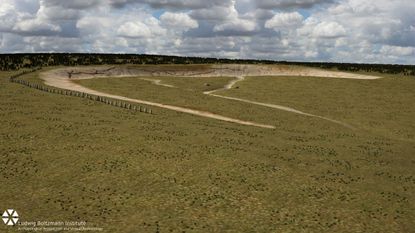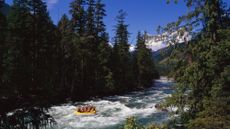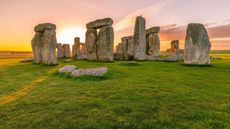'Archaeology on steroids': Huge stones found buried next to Stonehenge
Stone monument thought to be largest in Europe is likely to rewrite history about Neolithic Britain

A group of up to 90 standing stones found buried close to Stonehenge is thought to be the largest preserved stone monument ever discovered in Britain.
The site, which is thought to have been built about 4,500 years ago, is 1.8 miles from Stonehenge in Wiltshire.
The arrangements of stones buried under a grassy bank were found using ground-penetrating radar as part of the Stonehenge Living Landscapes archaeology project. Archaeologists believe the stones form part of a C-shaped Neolithic arena that faced directly towards the river Avon.
Subscribe to The Week
Escape your echo chamber. Get the facts behind the news, plus analysis from multiple perspectives.

Sign up for The Week's Free Newsletters
From our morning news briefing to a weekly Good News Newsletter, get the best of The Week delivered directly to your inbox.
From our morning news briefing to a weekly Good News Newsletter, get the best of The Week delivered directly to your inbox.
Arranged in a long line, the stones are likely to have marked a ritual procession route, and are thought to date from the same time as the sarsen circle at Stonehenge, the Daily Telegraph reports.
Professor Vince Gaffney leading the project declared: "It's utterly remarkable, it's just enormous. It is definitely one of the largest stone monuments in Europe and is completely unique. We've never seen anything like this in the world."
Gaffney went on to describe the development as "archaeology on steroids" saying: "Not only does the new evidence demonstrate a completely unexpected phase of monumental architecture at one of the greatest ceremonial sites in prehistoric Europe, the new stone row could well be contemporary with the famous Stonehenge sarsen circle or even earlier."
The stones lie on the edge of the Durrington Walls "henge" – an area of land surrounded by a 50ft wide ditch. Previously archaeologists had thought the builders of Stonehenge had lived at Durrington and that a wooden structure in Durrington known as Wood Henge had been a monument to the living as Stonehenge was to the dead.
However the new discovery has placed the site at Durrington at a much earlier moment in history than had been previously thought.
Paul Garwood, an archaeologist and historian on the project declared the findings to be crucial to understanding Stonehenge and the surrounding area.
"Everything written previously about the Stonehenge landscape and the ancient monuments within it will need to be rewritten," he said.
The research will be presented at the British Science Festival in Bradford this week.
Create an account with the same email registered to your subscription to unlock access.
Sign up for Today's Best Articles in your inbox
A free daily email with the biggest news stories of the day – and the best features from TheWeek.com
-
 Labour's Brexit conundrum
Labour's Brexit conundrumThe Explainer Keir Starmer backs 'twin track' strategy – build closer security ties with EU while ruling out single market, customs union and free movement
By The Week UK Published
-
 6 scenic white water rafting destinations to get your heart racing
6 scenic white water rafting destinations to get your heart racingThe Week Recommends Have a rip-roaring time on the water
By Catherine Garcia, The Week US Published
-
 Dangerous substances in Lunchables are raising concerns over children's health
Dangerous substances in Lunchables are raising concerns over children's healthIn the Spotlight High levels of lead and sodium were recently found in the snack packages
By Justin Klawans, The Week US Published
-
 George W Bush performs ‘history’s greatest Freudian slip’
George W Bush performs ‘history’s greatest Freudian slip’feature And other stories from the stranger side of life
By Chas Newkey-Burden Published
-
 Exhibition to explore Stonehenge’s parallels with Japanese stone circles
Exhibition to explore Stonehenge’s parallels with Japanese stone circlesfeature And other stories from the stranger side of life
By Chas Newkey-Burden Published
-
 Home Office worker accused of spiking mistress’s drink with abortion drug
Home Office worker accused of spiking mistress’s drink with abortion drugSpeed Read Darren Burke had failed to convince his girlfriend to terminate pregnancy
By The Week Staff Published
-
 In hock to Moscow: exploring Germany’s woeful energy policy
In hock to Moscow: exploring Germany’s woeful energy policySpeed Read Don’t expect Berlin to wean itself off Russian gas any time soon
By The Week Staff Published
-
 Were Covid restrictions dropped too soon?
Were Covid restrictions dropped too soon?Speed Read ‘Living with Covid’ is already proving problematic – just look at the travel chaos this week
By The Week Staff Last updated
-
 Inclusive Britain: a new strategy for tackling racism in the UK
Inclusive Britain: a new strategy for tackling racism in the UKSpeed Read Government has revealed action plan setting out 74 steps that ministers will take
By The Week Staff Published
-
 Mystery of Stonehenge finally ‘solved’
Mystery of Stonehenge finally ‘solved’feature And other stories from the stranger side of life
By The Week Staff Published
-
 Sandy Hook families vs. Remington: a small victory over the gunmakers
Sandy Hook families vs. Remington: a small victory over the gunmakersSpeed Read Last week the families settled a lawsuit for $73m against the manufacturer
By The Week Staff Published